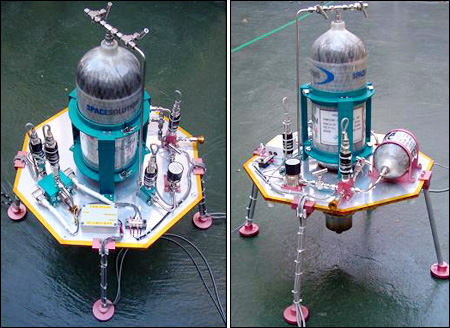[/caption] Everybody wants to go to the moon! Scientists from Korea recently unveiled a spacecraft developed completely in-house that could potentially be used for robotic exploration of the Moon. The mini-sized lander, shown above is about 40 centimeters tall (15.5 inches) and weighs 25 kilograms (55lbs). Scientists say it carry an additional 20 kilograms in payloads to the surface. Every part of the rocket engine was "homemade," said Kwon Se-jin, a professor of aerospace engineering at the Korea Advanced Institute of Science and Technology (KAIST). The lander, the result of a six year long effort, represents an advancement in technology, and an important step for Korea's nascent space program.
The rocket's propulsion includes a state-of-the-art propulsion and the engine's design allows it to be powered by environmentally friendly fuel. Also, the Korean team was proud of the low costs associated with their new lander.
According to Kwon, lunar modules between the 100 and 200 kilogram range, developed by NASA (National Aeronautics and Space Administration) under the International Lunar Network (ILN) project costs around $100 million. The rocket engine created by his team could cut development costs to about half that, Kwon claimed.
"We have approached NASA over the possibilities of using our engine,'' Kwon said, adding that his team is collaborating with other local scientists with the goal of landing a spacecraft on the moon by 2013.
"Lunar-landers are critical in developing lunar spacecraft, but advanced nations have been careful to protect their core technologies, so I think this is a big deal for us,'' he said.
South Korea has been pushing an aggressive space program over the past decade, and objectives include having a man on the moon by 2020.
Korea's current plans are to launch an Earth-orbiting satellite in early 2009 from a newly built spaceport. If successfully, Korea would become the ninth country to launch a satellite from its own soil.
But the Koreans also want to become part of an international space research project, the ILN, a project aiming to gradually place six to eight fixed or mobile science stations on the lunar surface. The stations will form a robotic network to replace the hardware left by the Apollo program to continue studies of the moon's surface and interior.
Source:
Korea Times
 Universe Today
Universe Today
